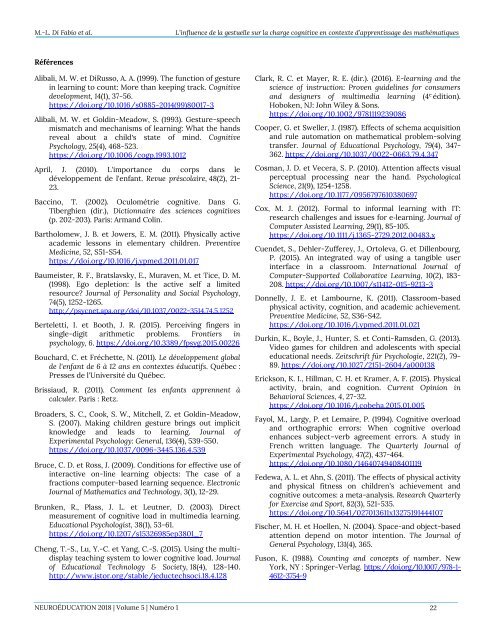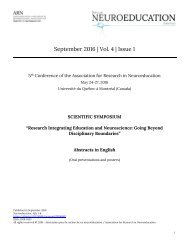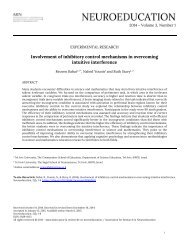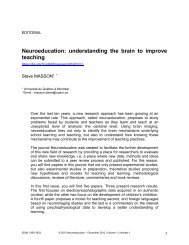Neuroeducation_2018_vol-5_no-1_full
Volume 5, Numéro 1 de la revue scientifique bilingue en libre accès Neuroéducation
Volume 5, Numéro 1 de la revue scientifique bilingue en libre accès Neuroéducation
- No tags were found...
You also want an ePaper? Increase the reach of your titles
YUMPU automatically turns print PDFs into web optimized ePapers that Google loves.
M.-L. Di Fabio et al.<br />
L’influence de la gestuelle sur la charge cognitive en contexte d’apprentissage des mathématiques<br />
Références<br />
Alibali, M. W. et DiRusso, A. A. (1999). The function of gesture<br />
in learning to count: More than keeping track. Cognitive<br />
development, 14(1), 37-56.<br />
https://doi.org/10.1016/s0885-2014(99)80017-3<br />
Alibali, M. W. et Goldin-Meadow, S. (1993). Gesture-speech<br />
mismatch and mechanisms of learning: What the hands<br />
reveal about a child′s state of mind. Cognitive<br />
Psychology, 25(4), 468-523.<br />
https://doi.org/10.1006/cogp.1993.1012<br />
April, J. (2010). L'importance du corps dans le<br />
développement de l'enfant. Revue préscolaire, 48(2), 21-<br />
23.<br />
Bacci<strong>no</strong>, T. (2002). Oculométrie cognitive. Dans G.<br />
Tiberghien (dir.), Dictionnaire des sciences cognitives<br />
(p. 202-203). Paris: Armand Colin.<br />
Bartholomew, J. B. et Jowers, E. M. (2011). Physically active<br />
academic lessons in elementary children. Preventive<br />
Medicine, 52, S51-S54.<br />
https://doi.org/10.1016/j.ypmed.2011.01.017<br />
Baumeister, R. F., Bratslavsky, E., Muraven, M. et Tice, D. M.<br />
(1998). Ego depletion: Is the active self a limited<br />
resource? Journal of Personality and Social Psychology,<br />
74(5), 1252-1265.<br />
http://psycnet.apa.org/doi/10.1037/0022-3514.74.5.1252<br />
Berteletti, I. et Booth, J. R. (2015). Perceiving fingers in<br />
single-digit arithmetic problems. Frontiers in<br />
psychology, 6. https://doi.org/10.3389/fpsyg.2015.00226<br />
Bouchard, C. et Fréchette, N. (2011). Le développement global<br />
de l'enfant de 6 à 12 ans en contextes éducatifs. Québec :<br />
Presses de l'Université du Québec.<br />
Brissiaud, R. (2011). Comment les enfants apprennent à<br />
calculer. Paris : Retz.<br />
Broaders, S. C., Cook, S. W., Mitchell, Z. et Goldin-Meadow,<br />
S. (2007). Making children gesture brings out implicit<br />
k<strong>no</strong>wledge and leads to learning. Journal of<br />
Experimental Psychology: General, 136(4), 539-550.<br />
https://doi.org/10.1037/0096-3445.136.4.539<br />
Bruce, C. D. et Ross, J. (2009). Conditions for effective use of<br />
interactive on-line learning objects: The case of a<br />
fractions computer-based learning sequence. Electronic<br />
Journal of Mathematics and Tech<strong>no</strong>logy, 3(1), 12-29.<br />
Brunken, R., Plass, J. L. et Leutner, D. (2003). Direct<br />
measurement of cognitive load in multimedia learning.<br />
Educational Psychologist, 38(1), 53-61.<br />
https://doi.org/10.1207/s15326985ep3801_7<br />
Cheng, T.-S., Lu, Y.-C. et Yang, C.-S. (2015). Using the multidisplay<br />
teaching system to lower cognitive load. Journal<br />
of Educational Tech<strong>no</strong>logy & Society, 18(4), 128-140.<br />
http://www.jstor.org/stable/jeductechsoci.18.4.128<br />
Clark, R. C. et Mayer, R. E. (dir.). (2016). E-learning and the<br />
science of instruction: Proven guidelines for consumers<br />
and designers of multimedia learning (4 e édition).<br />
Hoboken, NJ: John Wiley & Sons.<br />
https://doi.org/10.1002/9781119239086<br />
Cooper, G. et Sweller, J. (1987). Effects of schema acquisition<br />
and rule automation on mathematical problem-solving<br />
transfer. Journal of Educational Psychology, 79(4), 347-<br />
362. https://doi.org/10.1037/0022-0663.79.4.347<br />
Cosman, J. D. et Vecera, S. P. (2010). Attention affects visual<br />
perceptual processing near the hand. Psychological<br />
Science, 21(9), 1254-1258.<br />
https://doi.org/10.1177/0956797610380697<br />
Cox, M. J. (2012). Formal to informal learning with IT:<br />
research challenges and issues for e‐learning. Journal of<br />
Computer Assisted Learning, 29(1), 85-105.<br />
https://doi.org/10.1111/j.1365-2729.2012.00483.x<br />
Cuendet, S., Dehler-Zufferey, J., Ortoleva, G. et Dillenbourg,<br />
P. (2015). An integrated way of using a tangible user<br />
interface in a classroom. International Journal of<br />
Computer-Supported Collaborative Learning, 10(2), 183-<br />
208. https://doi.org/10.1007/s11412-015-9213-3<br />
Donnelly, J. E. et Lambourne, K. (2011). Classroom-based<br />
physical activity, cognition, and academic achievement.<br />
Preventive Medicine, 52, S36-S42.<br />
https://doi.org/10.1016/j.ypmed.2011.01.021<br />
Durkin, K., Boyle, J., Hunter, S. et Conti-Ramsden, G. (2013).<br />
Video games for children and adolescents with special<br />
educational needs. Zeitschrift für Psychologie, 221(2), 79-<br />
89. https://doi.org/10.1027/2151-2604/a000138<br />
Erickson, K. I., Hillman, C. H. et Kramer, A. F. (2015). Physical<br />
activity, brain, and cognition. Current Opinion in<br />
Behavioral Sciences, 4, 27-32.<br />
https://doi.org/10.1016/j.cobeha.2015.01.005<br />
Fayol, M., Largy, P. et Lemaire, P. (1994). Cognitive overload<br />
and orthographic errors: When cognitive overload<br />
enhances subject–verb agreement errors. A study in<br />
French written language. The Quarterly Journal of<br />
Experimental Psychology, 47(2), 437-464.<br />
https://doi.org/10.1080/14640749408401119<br />
Fedewa, A. L. et Ahn, S. (2011). The effects of physical activity<br />
and physical fitness on children's achievement and<br />
cognitive outcomes: a meta-analysis. Research Quarterly<br />
for Exercise and Sport, 82(3), 521-535.<br />
https://doi.org/10.5641/027013611x13275191444107<br />
Fischer, M. H. et Hoellen, N. (2004). Space-and object-based<br />
attention depend on motor intention. The Journal of<br />
General Psychology, 131(4), 365.<br />
Fuson, K. (1988). Counting and concepts of number. New<br />
York, NY : Springer-Verlag. https://doi.org/10.1007/978-1-<br />
4612-3754-9<br />
NEUROÉDUCATION <strong>2018</strong> | Volume 5 | Numéro 1 22








